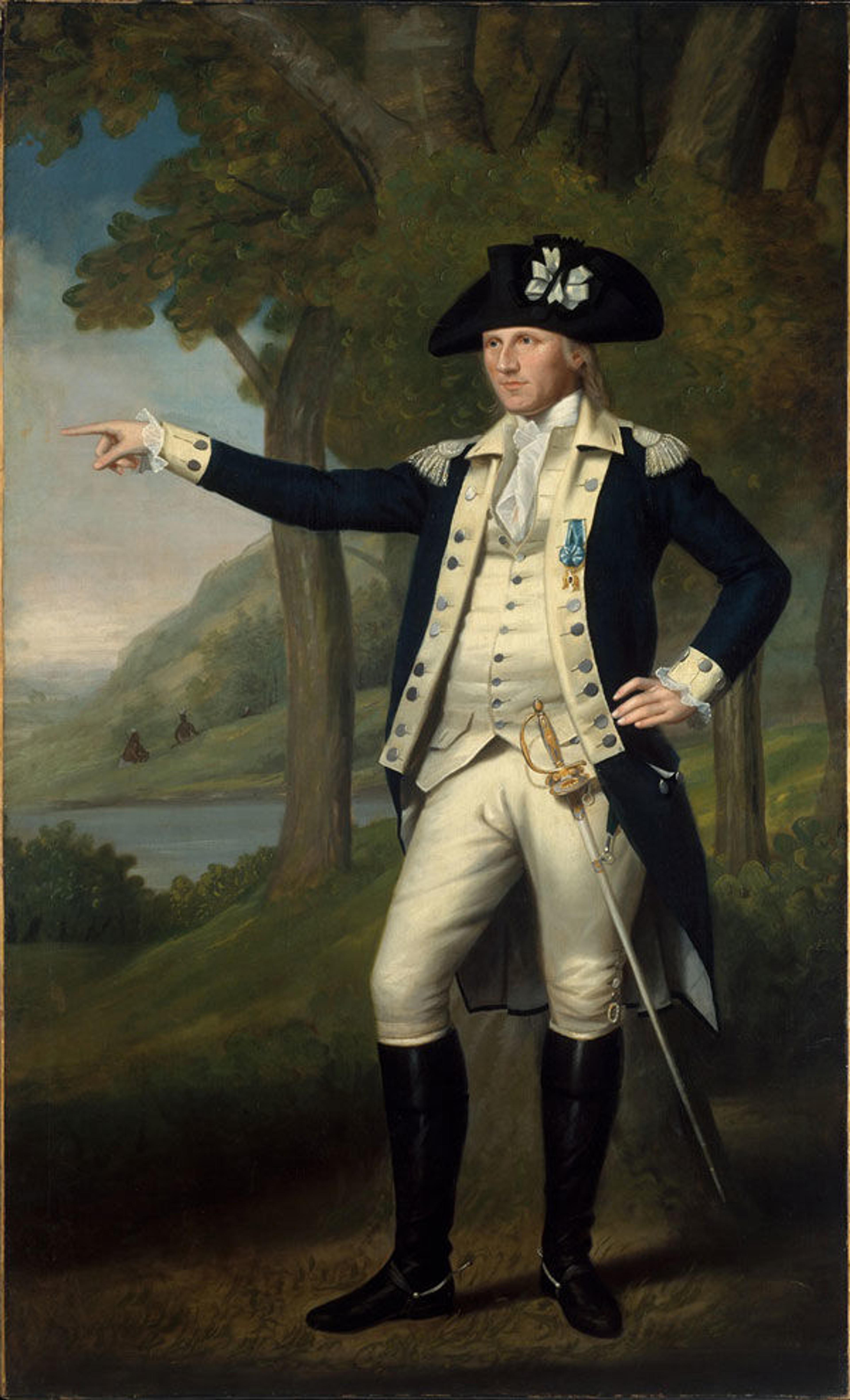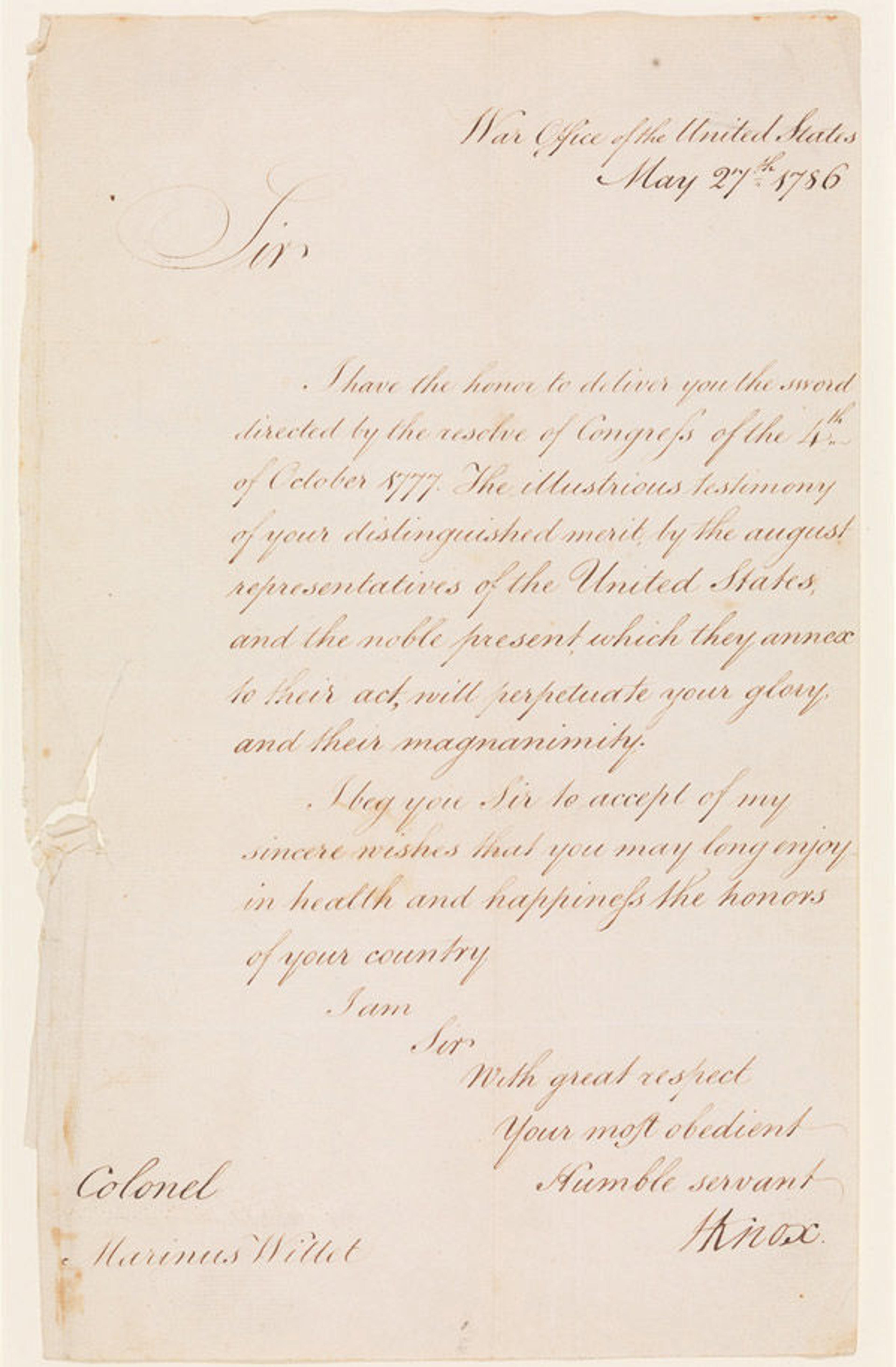The Sword Awarded to Revolutionary War Hero Colonel Marinus Willett

Ralph Earl (American, 1751–1801). Marinus Willett, ca. 1791. Oil on canvas. The Metropolitan Museum of Art, New York, Bequest of George Willett Van Nest, 1916 (17.87.1)
«The current exhibition Arms and Armor: Notable Acquisitions, 2003–2014 features a magnificent and historically important sword that was presented to the Revolutionary War hero Colonel Marinus Willett (1740–1830). In about 1791, American artist Ralph Earl (1751–1801) painted a full-length portrait of Willett (currently hanging in gallery 753 in The American Wing) that commemorates his extraordinary service during the War. Earl made a point of including a detailed rendition of the sword, which is shown hanging from Willett's waist.»
Willett led a varied career as a soldier, politician, and public servant. He attended Kings College (later Columbia University), then worked for a time in New York City as a cabinetmaker. His first military experience came during the French and Indian War; in 1758, Willett received a commission as an officer in a New York provincial regiment, which brought him to the Mohawk Valley, where he assisted in the construction of Fort Stanwix. A political radical, he became a leader of the New York Sons of Liberty, and fought valiantly during the Revolution. Upon receiving the rank of Lt. Colonel during the British siege of Fort Schuyler in August 1777, Willett led a successful attack against the Indian and loyalist camps in upstate New York.
Earl, who had escaped to England during the War, returned in 1785 with the intention of becoming a leading portrait painter for the new citizens of the Young Republic; he first encountered Willett while incarcerated in a debtor's prison in New York where, due to a modest debt he could not repay, he remained from September 1786 to January 1788. He was able to obtain his release by painting portraits of prominent New Yorkers At this time, Willett was serving as the sheriff of New York County and was a leading member of the newly formed Society for the Relief of Distressed Debtors, many of whom would have their portraits painted by Earl. Willett later wrote of his concern for these prisoners to Mayor DeWitt Clinton of New York:
Since my arrival here I paid a visit to the prison – the wretchedness there is past my power to attempt description – If distress ever claimed Legislative assistance, the melancholy situation of confined debtors in this place demand attention. (Willett to Clinton, March 11, 1791)
In his portrait of Willett, Earl turned to the formal style he developed while in London, using fluid brushwork and surface glazes. The figure is gracefully posed in a formal stance derived from British military portrait prototypes. He wears his regimental uniform, which includes a dark blue coat on which hangs the eagle badge of the Society of the Cincinnati.

C. Liger (French, recorded 1770–1793). Congressional presentation sword with scabbard of Colonel Marinus Willett (1740–1830), hallmarked for 1785–86. French, Paris. Steel, silver, gold. The Metropolitan Museum of Art, New York, Bequest of George Willett Van Nest, 1916 (17.87.3a, b)
Earl meticulously rendered the sheathed smallsword that Willett prominently wears at his waist. Willett had been presented with the sword by the Continental Congress in honor of his meritorious actions against the British at Fort Stanwix during the War, but Willett's sword and eleven of the same design for other officers were not executed until 1785–86. Willett received a letter from Henry Knox dated May 27, 1786, informing him of the delivery of the sword, which had been delayed due to a lack of funds.

Letter from Henry Knox (1750–1806), Secretary of War, to Colonel Marinus Willett (1740–1830), dated May 27, 1786. Ink on paper. The Metropolitan Museum of Art, New York, Purchase, Arthur Ochs Sulzberger Gift, 2008 (2008.314)
Rather than selecting an American craftsman for this important commission, Congress turned to C. Liger, one of the finest fourbisseurs (sword makers) in Paris. Willett's smallsword is made of steel with silver gilt and is placed in a sheath made of silver and shagreen (untanned leather). The grip of this smallsword is decorated with the coat of arms of the United States on one side and inscribed: "Congress / to / Col. Willett / Oct. 11, 1777" on the other. The long tradition of presenting swords to America's military leaders began with this group of twelve trophies.
Earl's portrait of Willett includes the presence of three Native Americans in the landscape background, seen at rest and holding rifles in nonthreatening poses, which alludes to Willett's celebrated role in negotiating a treaty with the Muscogee (Creek) Indians in 1790, an assignment given to him by George Washington. Willett was in favor of establishing peaceful solutions with the Native Americans, writing in 1792:
It has been uniformly my opinion that the United States ought to avoid an Indian War … The intercourse I have had with these people, [and] the treatment I have received … make me an advocate for them. To fight with them would be the last thing I desire.
After the war, Willett served two terms as sheriff, and in 1807, he succeeded DeWitt Clinton as the mayor of New York City. The portrait and sword descended in the Willett family to George Willett Van Nest, who bequeathed these family heirlooms to the Metropolitan Museum in 1917.
Elizabeth Kornhauser
Elizabeth Mankin Kornhauser is the Alice Pratt Brown Curator of American Paintings and Sculpture in The American Wing.